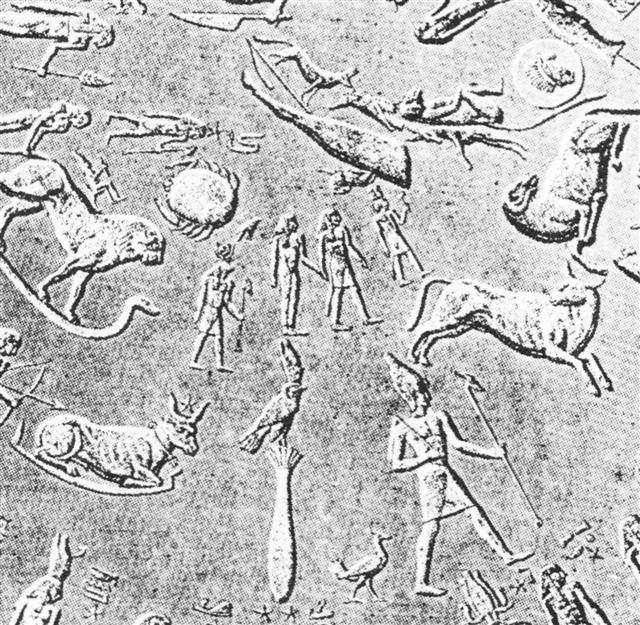3. The name Rehua presumably is Re-hua. And with hua equal to 'fruit' (all kinds of offspring), we can understand the saying that Rehua 'cooks' all 'fruit' - i.e. he is responsible for the fresh new products of summer: ... Antares, visible in the morning sky of December-January, came to stand for summer heat; hence the saying, 'Rehua cooks (ripens) all fruit' ... 250 = 35 * 7 + 5, which means it should be a Sun-day. 25 in conjunction with 10 can be imagined as Saturn (25) together with Sun (10), a fitting numerical combination for the beginning of summer. The hua poporo glyphs in line a7 could be related to the idea of 'ripening fruits', the regeneration of everything in summer. The first such sign is in Ga7-15, immediately before what we have assumed to be Rehua, and maybe we should read the pair of glyphs together:
Re in Rehua could be the same word as Re in Rei, and if so we could have a kind of 'rebus' (or rather glyph play) where the Rei glyphs are to be read together with the hua poporo glyphs in order to spell out Re-hua. I think the creator of the G text here was thinking of Rehua and his role in 'cooking' the summer 'fruits', and with such ideas in mind he would naturally have located hua poporo glyphs in line a7. The word re ought to be the opposite of rere, which in turn means to 'escape' or 'leave' (quickly like a bird):
At midsummer the Sun bird can be imagined as having arrived from the sky because it is getting quite warm and light. In the beginning he is high above, then in spring he is getting closer and closer, and at last he will 'alight', descend down to earth. This, I suggest, is the basic idea behind the Babylonian constellation Arrow, at the opposite corner of the sky roof compared to the sting of Scorpio:
South of the equator summer arrives with the sting of Scorpio, it seems, and maybe the sting 'kills' winter. But once in ancient Egypt summer evidently arrived with Gemini (where the ecliptic rises from the Milky Way), because below the later of the twins (Pollux) the Sun bird has alighted:
The present right ascension of Pollux is 07h 42m, which we can translate into day number (7 * 60 + 42) / 1440 * 365¼ = 117 (quite close to day number 116 for Procyon). 7 * 60 = 420 and 11 * 42 = 462. From Castor to Pollux there are 11m (3 days). The Twins could be the original pair of 'pieces' into which the cycle of the year was broken, and with Gemini in mind we can guess why there is a reversal at Ga4-6, just around the 'corner' of where the takaure season is ending:
The 'dry hua poporo' in Ga4-7 could indicate the season of straw, tell the reader that on Easter Island the time beyond Pollux does not lie in summer. And the henua in Ga4-6 (where we of course should read 24) is slightly bent (curved) at its top end as a possible sign of a reversal taking place between the twins. Also, the member in front in Ga4-5 is at the back side in Ga4-7. However, Ga4-6 is glyph number 117 counted from Gb8-30 - not from Gb6-26 - and the day number position is 64 + 117 = 181, which will put Phaed at Ga4-5:
The indicated reversal is therefore more plausibly showing the change from winter to summer at spring equinox (especially considering the end of the takaure season a few days earlier):
Since the time when Gemini stood at winter solstice they have moved forward in time due to the precession. If Gemini are mentioned in the G text we should search for them around glyph number 117 - 64 = 53:
Manu kake in Ga3-1 is probably connected with rising Sun because there are 300 glyphs ahead to what should be the end of the year:
This 'year' is beginning around 8 days beyond Pollux, it seems, at day 117 + 8 = 125 (a cube of 5). It is hardly a coincidence that manu kake (the climbing bird) is halfway from Sirrah to Rehua. Once Gemini stood at winter solstice, and due to the precession it has moved forward towards summer. North of the equator it could have been regarded as located 180 days after winter solstice, which would have been ca (180 - 125) / 365 * 26,000 = ca 3,900 years ago. This stretch of time apparently has diminished by 180 - 125 = 55 days, and we can speculate if it is related to why the true year has been shortened to 300 days - 355 days is 'one more' than 12 * 29½ = 354. Furthermore, 300 / 354 * 472 = 400. |
||||||||||||||||||||||||||||||||||||||||||||||||||||||||||||||||||||||||||||||||||||||||||||||||||||||||||||||||||||||||||||||||||||||||||||||||||||||||||||||||||||||||||||||||||||||||||||||||||||||

























